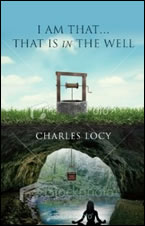Article first published as Book Review: ‘I AM That that is in the Well' by Charles Locy on Blogcritics.
November 14, 2013
I AM That that is in the Well
Charles Locy
ISBN: 9781935586586
Aviva Publishing (2012)
New Book Asks Readers to Ask, “Who Am I?” and Discover New Answers
 I am given to much thought after reading Charles Locy’s new book I AM That that is in the Well. Locy’s title may seem a bit like a mouthful or a tongue twister, but it is actually a word play on his previous book What’s in the Well Comes Up in the Bucket where he illustrated how who we are inside is how we approach the world. In this follow-up book, perfectly able to be read by itself, Locy illuminates the importance of how we refer to or define ourselves by using the words, “I am.” He embellishes upon this theme in chapters with titles like “I am what I say I am,” “I am the myth that I have created,” and “I am not what you say I am” until readers rethink how they think about themselves.
I am given to much thought after reading Charles Locy’s new book I AM That that is in the Well. Locy’s title may seem a bit like a mouthful or a tongue twister, but it is actually a word play on his previous book What’s in the Well Comes Up in the Bucket where he illustrated how who we are inside is how we approach the world. In this follow-up book, perfectly able to be read by itself, Locy illuminates the importance of how we refer to or define ourselves by using the words, “I am.” He embellishes upon this theme in chapters with titles like “I am what I say I am,” “I am the myth that I have created,” and “I am not what you say I am” until readers rethink how they think about themselves.
Through twenty chapters focused around the phrase “I am”—which proves just how significant this phrase is in our lives, although I doubt anyone other than Charles Locy has thought it through to this extent before—Locy demonstrates that because “I am what I say I am,” we can change what we say about and how we think of ourselves, to transform who we are into who we want to be. In short, Locy makes clear how important our words and thoughts are for guiding our lives. As he states: “You are or are not what you say you are or are not. You tell yourself constantly how you look, how you perform, how you act. If you say, ‘I am smart,’ you are smart. If you say, ‘I am no good at _____,’ don’t be surprised if you are no good at it.”
Locy, with poetic and philosophic grace, makes clear that what we put into the well, into our minds, consequently determines who we are. Just as or more true than “You are what you eat,” is “You are what you think” so we must be careful about what thoughts and images enter our minds, and that includes the more obvious distractions such as watching television, as well as the underlying negative thoughts we might not be fully conscious that we are thinking because we have not stopped to listen to them. Locy demonstrates how we can remove the negative thoughts and replace them with positive ones:
“Let happiness—doing what makes you happy—be your driving force. It (I will discuss IT in a later chapter) is natural. Accept the fact that it is natural to be happy. It is natural for us to pursue our passions. Anything short of that represents some fear or doubt in our lives. Happiness with a purpose must be your reason for living. Do not feel you are being selfish. You have my permission to be yourself.”
Locy reveals that the journey of self-discovery and self-redefinition is not always easy, but it can be an exciting and inspiring one: “And all personal growth comes from working with, and dealing with, the unknown. Discover the joy of the unknown.”
Chuck Locy’s I AM That that is in the Well is that unknown kind of a book that we least expect. It requires some slow thoughtful reading because the thoughts are deep, and yet they are written clearly and are very readable if you take the time to ponder them. To play on Locy’s favorite “well” theme, I’ll admit that “If a thing is worth doing, it’s worth doing well,” so you should definitely give yourself the pleasure of a slow read of Locy’s book, of a chance to discover unexplored territory, and in doing so, rediscover a new side of yourself, to redefine by your own choosing, who “I am” and to proclaim it boldly—I am sure you will find that adventure well worthwhile.
— Tyler R. Tichelaar, Ph.D. and author of the award-winning Narrow Lives

